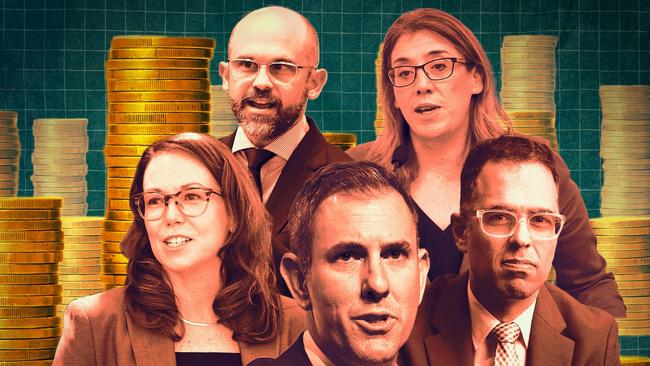Jim Chalmers faces pressure to reject $95bn GST carve-up
The Treasurer faces a backlash from his own state after its GST allocation was slashed by $2.4bn.

Jim Chalmers is under pressure to reject a controversial carve-up of the GST pool after the allocation for his home state of Queensland was slashed by $2.4bn in order to cover the needs of its cash-strapped southern neighbours.
Debt-laden Victoria is set to be the biggest winner of the annual $95.2bn allotment of the GST pot, which will increase by $4.5bn in the coming financial year, the Commonwealth Grants Commission said on Friday.
Victoria’s GST share will increase by $3.9bn to $26.15bn in 2025-26 – the highest of any state or territory – as the Allan government struggles to cover the cost of its pandemic-era spending binge and grapples with booming population growth.
But bumper coal royalties flowing to the Queensland Treasury mean the Crisafulli government will have its GST allotment cut to $16.6bn, down from $19bn, with the state’s LNP Treasurer David Janetzki demanding Dr Chalmers dismiss the “callous” proposal.
“The national pie is bigger but Queensland is getting a smaller slice,” Mr Janetzki said in parliament on Friday.
“This is an ominous sign of what could be in store for Queensland in the federal budget, which is just weeks away. Jim Chalmers falsely claimed before the election that a new [Crisafulli] government would gut Queensland like a fish. Little did we know that Jim Chalmers was planning to gut Queensland like a whale.”
Even as Mr Janetzki wrote to Dr Chalmers on Friday, demanding the commission’s decision be overturned, Dr Chalmers showed little appetite to give into the Crisafulli government’s calls.
“The Commonwealth Grants Commission is entirely independent and operates at arm’s length from government,” a spokeswoman for Dr Chalmers said.
While Queensland has traditionally been a net recipient of GST revenues, coal royalties imposed by the former Miles Labor government have meant the state has begun to subsidise other jurisdictions, receiving 95c per person from the GST pool in 2024-25.
For the 2025-26 financial year, the commission recommended that amount be reduced to 85c. By contrast, Victoria will for the first time be subsidised by other jurisdictions, collecting $1.07 per person from the GST pot from July 1 after the state also missed out on a surge in mining royalties.
Victorian Treasurer Jaclyn Symes welcomed the commission’s recommendation, claiming that her state had been shortchanged by as much as $31bn since the GST’s inception.
“This distribution of the GST has never been fair, which is why we welcome the recommendation from the Commonwealth Grants Commission,” Ms Symes said, committing to use the additional funding to “deliver the priorities of Victorians”.
The current carve-up process distributes Australia’s GST revenue annually via an opaque and convoluted process which accounts for states’ revenue-raising ability and spending needs.
That allocation system, however, has attracted criticism from the eastern states, which argue they have been left worse off after a deal brokered between the Turnbull and McGowan governments.
The arrangement, struck by then-treasurer Scott Morrison, guaranteed that WA received at least 70c per person from the GST pot from mid-2019 after the state’s GST share collapsed due to soaring commodity royalties. That floor rose to 75c from July 1 last year. Under the agreement, the federal government agreed to compensate other states and territories with top-up payments such that they were “no worse off” from the decision to give WA a larger slice of Australia’s GST pie.
Except for Queensland, the commission recommended all other states receive more in GST and so-called “top-up” payments, with NSW set to be the second-largest beneficiary of the arrangements. On top of its $25.48bn allocation, it will receive $1.3bn in 2025-26, taking its total share to $27.7bn. Victoria’s top-up payment will take its total allocation to $28bn.
Despite the increase, NSW Treasurer Daniel Mookhey described the funding arrangements as “an affront to the state”, and renewed his demands for the GST revenue allocation to instead be determined by population alone.
“We will continue to argue for a fairer carve-up of GST on a per capita basis, along with other measures to make the system more transparent,” Mr Mookhey said.
WA Treasurer Rita Saffioti, however, defended the lucrative GST allotment which will provide her state $7.8bn next financial year, up $395m.
“I’ve said repeatedly that while we are blessed with being a resource-rich state, those resources don’t just jump out of the ground and onto the boat,” Ms Saffioti said. “WA Labor invests billions to support the resources sector, which in turn supports the entire country.”
Without the Turnbull-era reforms, Western Australia would receive just 18c per person from the GST pot. The top-up payments are expected to cost the federal budget $4.9bn in the 2025-26 financial year, the commission said, taking the total cost of the deal to the commonwealth to approximately $30bn since 2018.
Despite the significant impost to the federal budget, which is expected to remain in deficit for another decade, both Anthony Albanese and Peter Dutton have expressed their strong commitment to retaining the existing arrangements to court support from WA voters.







To join the conversation, please log in. Don't have an account? Register
Join the conversation, you are commenting as Logout